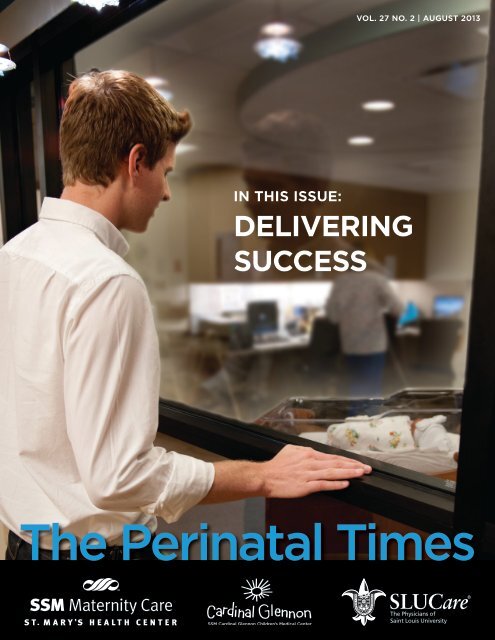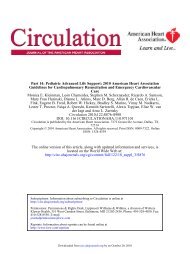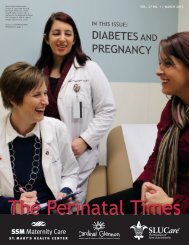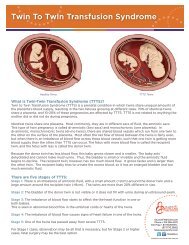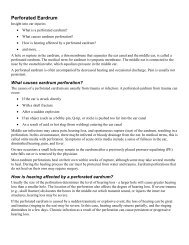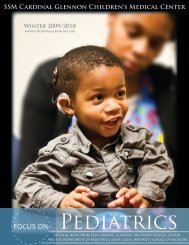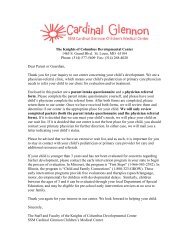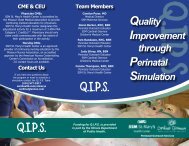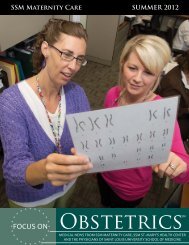print and read version - SSM Cardinal Glennon Children's Medical ...
print and read version - SSM Cardinal Glennon Children's Medical ...
print and read version - SSM Cardinal Glennon Children's Medical ...
- No tags were found...
You also want an ePaper? Increase the reach of your titles
YUMPU automatically turns print PDFs into web optimized ePapers that Google loves.
VOL. 27 NO. 2 | AUGUST 2013IN THIS ISSUE:DELIVERINGSUCCESSThe Perinatal Times
VOL. 27 NO. 2 | AUGUST 2013THE PERINATAL OUTREACH PROGRAMThe Perinatal Outreach Program is a collaborative effortbetween <strong>SSM</strong> Maternity Care at St. Mary’s Health Center, <strong>SSM</strong><strong>Cardinal</strong> <strong>Glennon</strong> Children’s <strong>Medical</strong> Center <strong>and</strong> Saint LouisUniversity School of Medicine.It is designed to improve outcomes for mothers <strong>and</strong> babiesthrough educational programs <strong>and</strong> quality improvementactivities for regional perinatal care providers in eastern Missouri<strong>and</strong> Southern Illinois.The Perinatal Outreach Program is the designated AdministrativePerinatal Center for Southern Illinois.PERINATAL TIMES EDITORIAL BOARDConnie Thompson, RNC, BSN, Editor<strong>SSM</strong> <strong>Cardinal</strong> <strong>Glennon</strong> <strong>SSM</strong> St. Mary’s Health CenterChildren’s <strong>Medical</strong> Center Erol Amon, MD, JDAyoob Ali, MD, MPHKathy Canchola, RN, BSNGlenn Barber, RNC, BSN Gilad A. Gross, MDRobyn Gude, RN, MSN Katie Kulaitis, RN, BSNMary Hope, RN, BSNThomas Myles, MDWilliam Keenan, MDPam R<strong>and</strong>azzo, RNC, BSNPatricia OberkirschSharon Rector, RNC, MSNJudy Wilson-Griffin, RNC, PNCNSFUNDINGFinancial support for the The Perinatal Times is provided by<strong>SSM</strong> Health Care - St. Louis <strong>and</strong> the Illinois Department ofPublic Health.LETTERSThe Perinatal Times welcomes comments on any of its articles<strong>and</strong> will consider such letters for publication. Suggestions forfuture topics of interest or announcements are encouraged.Please send correspondence to:The Perinatal TimesConnie Thompson, Editor<strong>SSM</strong> St. Mary’s Health Center6420 Clayton Road, Richmond Heights, MO 63317connie_thompson@ssmhc.comIN THIS ISSUE:13456MONITOR8ACTIVENRP IN THEKNOW: DELIVERYROOM OXIMETRYFORMULARYFACTS: HIV REVIEW& UPDATESOPTIMAL TIMING OFUMBILICAL CORDCLAMPING AFTER DELIVERYRESOURCE ROUND-UP:THE LATEST RESOURCESIN ONE SPOTCORNER:IRREGULARITIES OF FETALCARDIAC RHYTHMMANAGEMENTOF THE THIRD STAGE OFLABOR – HOW ACTIVE IS IT?To be added to The Perinatal Times email list to receivean electronic <strong>version</strong>, please email Patricia Oberkirsch atpatricia_oberkirsch@ssmhc.com
NRP IN THE KNOWDELIVERY ROOM OXIMETRY BY GLENN BARBER, RNC-NIC, BSNA 22 year old primigravida mother was admitted in activelabor <strong>and</strong> delivered a 39 2/7 week gestation infant with clearamniotic fluid. The mother had an uncomplicated pregnancy<strong>and</strong> received good prenatal care. Immediately after birth,the infant was non-vigorous. The baby was placed under aradiant warmer, dried, stimulated <strong>and</strong> positioned with thehead slightly extended. The infant had no respiratory effort<strong>and</strong> bag/mask ventilation was started on room air (21%FiO2). After 15-20 seconds of effective ventilation, the heartrate was auscultated at 80 beats per minute <strong>and</strong> the infantshowed no signs of improvement. Which of the followinginterventions would be appropriate for this infant?1. Evaluate the skin color. If cyanotic, increase the oxygento 100%.2. Place oximetry probe on left wrist/h<strong>and</strong> <strong>and</strong> considergiving blended oxygen based on NRP target oxygensaturations.3. Place oximetry probe on right wrist/h<strong>and</strong> <strong>and</strong> considergiving blended oxygen based on NRP target oxygensaturations.4. Start chest compression <strong>and</strong> consider giving a dose ofEpinephrine.CORRECT RESPONSEPlace oximetry probe on right wrist/h<strong>and</strong> <strong>and</strong> consider givingblended oxygen based on NRP target oxygen saturations.DISCUSSIONAccording to the Neonatal Resuscitation Program (NRP), 6thedition, the goal is to achieve pre-ductal oxygen saturationssimilar to those of a healthy term neonate during the first10 minutes after delivery. Based on studies that evaluatednewborns undergoing normal transition, the NRP hasset targeted pre-ductal oxygen saturations that begin at60% at birth <strong>and</strong> allows 10 minutes to reach 90%. 1,2Usingoximetry <strong>and</strong> oxygen blenders in the delivery room is arecommendation that has been a practice change for manyhealth care providers. Oximetry is recommended in thefollowing situations: 3»»When resuscitation is anticipated»»When positive-pressure ventilation is required for morethan a few breaths»»When central cyanosis is persistent»»When supplemental oxygen is administered»»To confirm your perception of cyanosisProper placement of the oximeter probe is crucial. The probeshould be positioned on the right wrist or h<strong>and</strong> to evaluatepre-ductal oxygen saturations. This allows the clinician toassess the oxygen saturation of the blood in the aorta beforeit reaches the ductus arteriosus. A probe placed on the lefth<strong>and</strong>/wrist or feet (post-ductal) may have a lower saturationbecause of the possible mixing of blue blood from thepulmonary artery. The ductus arteriosus may remain open forseveral hours after birth.For the most rapid signal, the probe should be place on theinfant before it is connected to the oximeter. Most oximetersrequire a consistent pulse foran accurate & trustworthy<strong>read</strong>ing.Once a reliable oxygensaturation is displayed,an increased percentageof inspired oxygen maybe indicated. The oxygenconcentration can beadjusted from 21% to 100% byusing an air-oxygen blender.Using the blender, theoxygen should be titrated toachieve the target pre-ductalsaturation values based on the age of the infant (see Table 1).The goal is to give just the right dose of oxygen that is nottoo high or too low – either of which can be harmful. •REFERENCESTABLE 1Targeted Pre-ductalSPO2 After Birth1 min 60% - 65%2 min 65% - 70%3 min 70% - 75%4 min 75% - 80%5 min 80% - 85%10 min 85% - 95%1. Dawson JA, Kamlin OF, Vento M, et al. Defining the ReferenceRange for Oxygen Saturation for Infants After Birth. Pediatrics.2010; Jun; 125:e1340-1347.2. Mariana G, Dik PB, Ezquer A, et al. Pre-ductal <strong>and</strong> Post-ductal O2Saturation in Healthy Term Neonates after Birth. J. Pediatr. 2007;150:418-21.3. Kattwinkel J, McGowan JE, Zaichkin J. Textbook of NeonatalResuscitation. 6th ed. Elk Grove Village: American Academy ofPediatrics; 2011.ABOUT THE AUTHORGlenn Barber is a Neonatal Outreach Educator in the PerinatalOutreach Department at <strong>SSM</strong> <strong>Cardinal</strong> <strong>Glennon</strong>. Glenn is a RegionalNRP Instructor <strong>and</strong> a Lead STABLE Instructor with almost 25 years ofclinical experience. He is also nationally recognized as a Master Trainerfor the Helping Babies Breathe (HBB) Program. Contact Glenn atglenn_barber@ssmhc.comTHE PERINATAL TIMES | 1
of delivery. The mechanism of transmission can be throughmaternal-fetal transfusion of blood during labor. Also theinfant skin or mucous membranes may come into contactwith infected blood during the delivery. Factors that furtherincrease the risk are duration of membrane rupture <strong>and</strong>women who have a viral load greater than 1000.HIV TESTINGBecause of the significant decrease in the incidence ofneonatal HIV infection when women receive treatment inlabor, all women without documentation of HIV status shouldbe screened with rapid HIV testing when presenting in labor,unless they decline. Women with positive rapid HIV antibodytests should be presumed to be infected until st<strong>and</strong>ard HIVantibody confirmatory testing clarifies their infection status.IV zidovudine should be started immediately in all womenwith positive rapid HIV tests in labor to prevent perinataltransmission of HIV (see figure 1).Since 2003, the State of Illinois has m<strong>and</strong>ated the following inregards to pregnant women:»»St<strong>and</strong>ardized <strong>and</strong> m<strong>and</strong>ated counseling of all pregnantwomen»»Requires that HIV test results be documented inprenatal, labor <strong>and</strong> delivery, <strong>and</strong> newborn pediatriccharts»»Requires that rapid tests be offered on labor <strong>and</strong>delivery to women without a documented HIV status»»Requires m<strong>and</strong>atory testing of newborns when themother’s status is unknown at birth»»M<strong>and</strong>ated that all preliminary positive rapid HIV testson mothers <strong>and</strong> infants be reported to the 24/7 IllinoisPerinatal HIV Hotline, 1-800-439-407, within 24 hoursof birth to ensure medical consultation <strong>and</strong> linkage tocase managementADDITIONAL HIV RESOURCES»»314-535-7275Project ARK - 24/7 AIDS <strong>and</strong> HIV resources <strong>and</strong>knowledge»»1-888-448-8765Perinatal Hotline – National Perinatal HIV Consultation<strong>and</strong> Referral Service with around-the-clock adviceon testing <strong>and</strong> care of HIV-infected women <strong>and</strong> theirinfants including referral to HIV specialists <strong>and</strong> regionalresources»»HIVtesting@nccc.ucsf.edu»»www.cdc.gov/hiv»»www.aidsinfo.nih.gov - Treatments <strong>and</strong> clinical trials»»www.aids.gov - Comprehensive government HIVresources •REFERENCES1. www.aidsinfo.nih.gov - AIDSinfo, Offering information onHIV/AIDS treatment, prevention <strong>and</strong> research2. www.cdc.gov/hiv - Centers for Disease Control <strong>and</strong> PreventionABOUT THE AUTHORLaurie Niewoehner is a Clinical Pharmacy Specialist at <strong>SSM</strong> St. Mary’sHealth Center. She attended University of Minnesota <strong>and</strong> completed aspecialty residency program in Pediatrics at Children’s Mercy Hospital<strong>and</strong> the University of Missouri-Kansas City School of Pharmacy inKansas City. Laurie is also a preceptor for Neonatology <strong>and</strong> Women’sHealth.THE PERINATAL TIMES | 3
MONITOR CORNERIRREGULARITIES OF FETAL CARDIAC RHYTHM BY SHARON RECTOR, RNC-OB, C-EFM, MSNCardiac arrhythmia can be simply defined as a variationfrom the normal rhythm of the heart. Fetal arrhythmiasare fairly uncommon occurring in only 1%-3% of allpregnancies (Barnes, 2009). There are three main typesof rhythm disturbances seen in the fetus: irregular heartrhythms, tachyarrhythmias (baseline rate above 180bpm) <strong>and</strong> bradyarrhythmias (baseline rate below 100bpm). Irregularities of fetal cardiac rhythm are the mostcommon type of fetal arrhythmia <strong>and</strong> rarely have seriousconsequences, while sustained tachyarrhythmias <strong>and</strong>bradyarrhythmias can lead to severe complications includingheart failure <strong>and</strong> hydrops fetalis.IRREGULAR RHYTHMSIrregularities in rhythm seen in the fetus include prematureatrial contractions (PACs), premature ventricular contractions(PVCs) <strong>and</strong> dropped beats (nonconducted impulses). PACsare the most common fetal arrhythmia <strong>and</strong> the most commonirregular rhythm. They are usually caused by an ectopicfocus, but they can be exacerbated by maternal ingestion ofcaffeine, decongestant medication (stimulants), or nicotine(Sklansky, 2009). On the electronic fetal monitor (EFM) usingthe external ultrasound transducer, premature contractionsshould be audible as an irregular rhythm <strong>and</strong> they usuallycause temporary moments of “lift off” or gaps on the tracing.With an internal fetal spiral electrode, PACs will appear asan upward <strong>and</strong> downward deflection from the baseline. Theupward spike represents the premature atrial contraction,<strong>and</strong> the downward spike represents the compensatory pause(Barnes, 2009). In most instances the FHR baseline will bevisible between these upward <strong>and</strong> downward spikes. PACsdo not represent any real risk to the fetus, <strong>and</strong> they usuallyresolve spontaneously after birth.PVCs are less common than PACs, <strong>and</strong> they are caused byan ectopic focus in the ventricles that triggers a prematureventricular contraction. PVCs also appear as upward <strong>and</strong>downward deflections from the baseline when using theinternal fetal spiral electrode (Barnes, 2009). They too areconsidered benign <strong>and</strong> usually disappear shortly after birth.Both PACs <strong>and</strong> PVCs can occur as bigeminy (occurring everysecond beat), trigeminy (occurring every third beat), or atr<strong>and</strong>om intervals (Barnes, 2009). Dropped beats (or skippedbeats) are the result of nonconducted impulses in the atria,<strong>and</strong> they appear as downward deflections from the FHRbaseline.TRACING 1VOL. 27 NO. 2 | AUGUST 2013
While irregular rhythms are audible <strong>and</strong> can be observed onthe internal EFM tracing, they can be diagnosed empiricallyby observing the rhythm with 2D ultrasound imaging.However, to confirm the diagnosis, echocardiography withDoppler flow studies or M-mode analysis can be utilized(Sklansky, 2009). Again, most irregularities in fetal cardiacrhythm are benign, however, they should be documented <strong>and</strong>reported for evaluation because on rare occasions they mayconvert to a more serious cardiac arrhythmia or be associatedwith a structural cardiac defect.The following EFM tracings are from a 23 y/o, G2P0010admitted at 40 weeks gestation in spontaneous labor.The fetus had previously been diagnosed with a cardiacarrhythmia that was confirmed as PACs via ultrasound <strong>and</strong>echocardiography.An audible arrhythmia was noted on admission via externalfetal monitoring. The first tracing was obtained with externalEFM – note the multiple areas of lift off. The second tracingwas obtained via internal fetal spiral electrode – note themultiple occurrences of upward <strong>and</strong> downward deflections.Notice how they are of varying lengths, but yet they canall be placed into one of several groups that appear verysimilar. This suggests that there are multiple ectopic sites.Also note that the baseline FHR (115 bpm) can be identifiedthrough the arrhythmia. Artifact (or loss of signal) can alsoappear as deflections from the baseline, but it will appearextremely inconsistent <strong>and</strong> in most cases without a visiblebaseline. This fetus was born via spontaneous vaginal deliverywith Apgar scores of 9 <strong>and</strong> 9 at one <strong>and</strong> five minutes. A rareirregularity of rhythm was noted via auscultation. The infantreceived routine newborn care <strong>and</strong> was discharged withoutcomplication. •REFERENCESBarnes, J.D. (2009). Fetal arrhythmias. In A. Lyndon & L.U. Ali (Eds.).Fetal heart monitoring: Principles <strong>and</strong> practices (4th ed., pp. 267-291). Washington, D.C.: Association of Women’s Health, Obstetric <strong>and</strong>Neonatal Nurses.Sklansky, M. (2009). Fetal cardiac malformations <strong>and</strong> arrhythmias. InR.K. Creasy, R. Resnik, J.D. Iams, C. Lockwood, & R.R. Moore (Eds.).Maternal-fetal medicine: Principles <strong>and</strong> practice (6th ed., pp. 305-345).Philadelphia: W.B. Saunders.ABOUT THE AUTHORSharon Rector is an Education Consultant specializing in perinatalnursing at <strong>SSM</strong> Health Care in St. Louis.TRACING 2THE PERINATAL TIMES | 7


